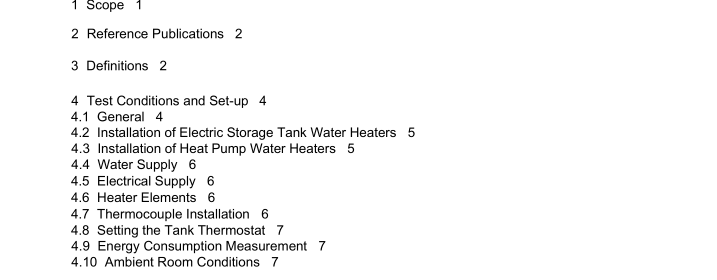CSA C745-03 pdf download – Energy Efficiency of Electric Storage Tank Water Heaters and Heat Pump Water Heaters.
3 Definitions The following definitions apply in this Standard: Controlled temperature differential — the difference between the water temperatures in degrees Celsius at the level of the temperature-sensitive element of the thermostat at cut-in and cut-out under standby conditions. Cut-in — the time or temperature at which a water heater thermostat has acted to start the application of heat to the water. Cut-in temperature — the minimum water temperature obtained in the top-of-tank for any particular setting of the thermostat. Cut-out — the time or temperature at which a water heater thermostat has acted to stop the application of heat to the water. Cut-out temperature — the maximum water temperature obtained in the top-of-tank for any particular setting of the thermostat. Design power rating — the nominal power rating that a water heater manufacturer assigns to the heat source of a particular design of water heater heating means, expressed in kilowatts (kW). Electric storage tank water heater — an automatically controlled, thermally insulated, electrically heated storage tank. The tank can be free-standing (floor-mounted) or wall-mounted. Under-the-counter or countertop storage tank water heaters are classified separately as “tabletop water heaters”. Energy factor — a measure of the overall efficiency of a water heater expressed as the ratio of the energy supplied in heating water daily to the total daily energy consumption of the water heater.
First-hour rating — the amount of hot water that the water heater can supply in the first hour of operation. It is a combination of how much water is stored in the water heater and how quickly the water heater can heat cold water to the desired temperature. Heater element — a complete or partial assembly of a heating element, electrical insulation (e.g., mica, magnesium oxide), thermal insulation or air space, metal sheath or plate, and flange, heater block, or other mounting means. Heat pump water heater — a water heater that utilizes electricity as an energy source for the transfer of thermal energy from one temperature level to a higher temperature level for the purpose of heating water. This includes all necessary auxiliary equipment such as fans, storage tanks, pumps, and necessary controls.
Heat source — a device that supplies heat to the water, such as a heater element or the output of a heat pump. Heat trap — a device that can be integrally connected or independently attached to the hot- or cold-water pipe connections of a water heater. The device develops a thermal or mechanical seal to minimize the recirculation of water due to natural thermal convection between the water heater tank and its water supply pipes and thereby reduces the heat lost to the environment from the hot water stored in the water heater. High-temperature water heater — an assembly that is designed to operate with water temperatures in excess of 82 ºC (180ºF) and consists of a water tank, heater elements, thermostats, insulation, outer shell, and a tempering system to limit the temperature of water delivered from the assembly to less than 60 ºC (140ºF). Idling period — the period of time following the first cut-out of the lower thermostat after an adjustment of the thermostat setting or the elimination of accumulated air during which no water is withdrawn and all other test conditions remain unchanged. Immersion heater element — a heater element mounted with the heating surface completely within the tank. Interlock — that operation of the upper thermostat whereby the supply to the upper heater element is closed while that to the lower heater element is simultaneously opened and vice versa. This is frequently referred to as “flip-flop” operation. Lower heater element — the element so positioned as to heat the entire quantity of water within the tank. Lower thermostat — the thermostat that controls the lower heater element.CSA C745-03 pdf download.
